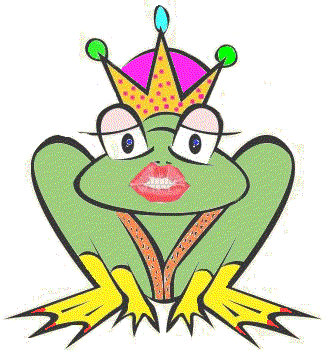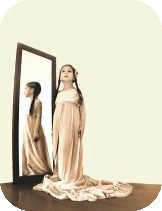July 2009
Member Editorial
(The Artistic Anathema) Written By CDHM Artisan
Betsy Niederer
of Betsy Niederer Miniatures

 One thing that I've discovered from teaching miniature food classes is that most of us are visual learners. But visual learning can only take an artist so far before that next all-important step of personal creativity must be made. By staying in that visual learning stage, an artist runs the risk of being labeled “derivative” or – shudder - "copying."
One thing that I've discovered from teaching miniature food classes is that most of us are visual learners. But visual learning can only take an artist so far before that next all-important step of personal creativity must be made. By staying in that visual learning stage, an artist runs the risk of being labeled “derivative” or – shudder - "copying."
It’s normal to learn by watching an instructor go through the steps and copy the class prototype. I am a very visual person. If I look at a tutorial or read a book of instructions I scratch my head and say "Huh?" if there aren't a lot of pictures.
From my own experience, I know that the beginning is the worst. I remember feeling totally frustrated because my miniature cakes looked like rabbit pellets. So I bought some books. I learned from the beautifully photographed pages of Sue Heaser and Angie Scarr. I sat at my kitchen table and worked until I had clay food that looked (more or less) like something edible.
But guess what? My miniature breads looked exactly like Sue Heaser's and my miniature chickens looked just like Angie Scarr MIniatures's. Ok, so I kept making Sue's breads and Angie's chickens for a while, and I sold them to pay for my clay habit. I apologize to everybody who bought them. It wasn't my fault; I was a visual learner who hadn’t taken the next step into my own creative style.

That next step came after I was pretty comfortable making the basic stuff, but it wasn't looking as real as I'd like it to. I searched Michael's, my local craft store, anywhere I could think looking for anything that could possibly be used, mixed or combined to make my work look better. You wouldn't believe some of the nasty combinations that I came up with – but eventually I figured out some techniques to make my work better, more realistic and hopefully wouldn’t explode in my oven and send me running for the chocolate.
Out of all the investigation, practice and hideous kitchen messes, something funny happened. My miniature food stopped looking like Angie Scarr's and Sue Heaser's.
I was having so much fun I decided to share what I'd learned from all of that time in the kitchen, mixing noxious chemicals and melting things in the oven. As I became involved with miniature message boards, e-mailing other miniaturists and chatting with miniature food makers at shows, another interesting thing happened. Although I worked in semi-isolation in a small town in Pennsylvania there were lots of other people out there using the exact same techniques I thought I had 'discovered', alone in my kitchen watching the 11:00 p.m. news. Who'd have thought?
Even while sitting in my kitchen late at night, never having met another miniaturist and working while watching TV re-runs, I was living up to the saying "there are no new ideas".
For those of us who are new to miniature food, it is interesting to know that they were making miniature food canes in the early 1980s. Before that miniature food was made from plaster, paper mache, plastic, wood, and metal. 
I don't know who the first person was to make a miniature roasted chicken, but I can assure you with confidence that it wasn't Angie Scarr and it most certainly wasn't me.
If you work hard, you will eventually develop your own style. It is a given. If you haven't yet, then you just have to practice more. I can identify the work of many food artists just by their individual styles. They've grown from 'copying the teacher' to developing their own techniques and applying their own creativity.
To get your work to stand out, think about what you love - shabby yet chic, turn of the century France, country farm house, Tudor, diners or shops - then do your research. Learn all that you can about it. Then think about what collectors might want. Look at the CDHM Galleries, Ebay and Etsy to see what is selling now. Go to the library and look at all of the 'style' magazines that you can get your hands on – these are filled with beautiful arrangements of everything from food to fabrics. Start a file of photos that you like and refer to them when you are in a creative slump.
And all that hard work can pay for your clay habit when you sell your original creations. This is where your own creativity is so important, and where the evil word 'copying' can get everybody upset. Original works are those that do not mimic the specifics of other people's work.
Here's an example:
Artist B sees them, likes them a lot and decides to make a similar work board - except with the exact same dishes, food, fabric and arrangement style.
The result is close enough to cause some people to say "gee that looks a lot like Artist A's work". If Artist B keeps that piece for display in his/her home, no big deal. But offering it for sale equals an infringement of Artist A's intellectual property rights. Not to mention that Artist A is going to be pretty darn upset.
If Artist B was so inspired by the board then some creativity should have been shown in making a completely new version. How? It can certainly be the same subject, but arranged differently, with different fabrics/dishes/wood/etc., additional components like a cookbook, Photoshopped boxes or containers – anything to make the piece original, creative and all your own.
So, what happens if you’re Artist A? You have two options:
The first is to take legal action, usually a lawyer-generated 'Cease and Desist' letter. Often this is enough to get the Artist B to stop, but it can be expensive and time consuming, as well as ineffective if the copier is in another country.
Option two is to ignore it and move on; knowing that your work is good enough that somebody wants to copy it but theirs will never be the same quality as the original, your own.
The bottom line for artists is to:
1) Realize that the internet gives millions of people access to your pictures, and tutorials.
2) If you are willing to share one of your techniques with the public, you have to let go,
it is no longer exclusive.
3) Posting a picture of an original design becomes your intellectual property.
The bottom line for students (and other artists) is to:
1) Realize that it is illegal to sell art work that is a copy of another artists' original design.
2) While it is expected that initially, your technique may resemble your teachers, it is also expected
that you respect your teacher's designs and develop your own creative style.
And if you’re Artist B? Copying might be the sincerest form of flattery but it limits and demeans you as an artist. Practice, study and find your own flair. I promise it’s there if you’ll just work hard enough to find it. And the creative journey is more than worth it.
Betsy Niederer
of Betsy Niederer Miniatures
CDHM Artisan and IGMA Fellow
Custom Dolls, Houses & Miniatures / CDHM




